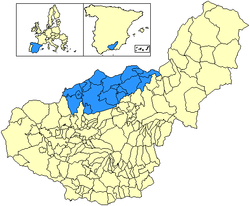Geography
In the eastern part of the region, the zone or sub-county of Montes Orientales is located. The sub-county of Montes Orientales is located in the northeast part, occupying around of 1,400 km2, which extends from Fardes and Guadiana Menor rivers to Frailes river. Its main mountainous system, located in the east, is Sierra Arana, a double limestone anticlinal alignment of 30 km of length, with an average altitude of 1,200 m.a.s.l (metres above sea level), being its highest level the Cerro or Peñón de la Cruz, with 2,030 m.a.s.l.
It is subdivided into the sub-county of Iznalloz (district capital), in the transition zone with the western part, and the sub-county of Pedro Martínez, more to the eastward. It predominates a landscape dominated by the hills with traditional agriculture, with herbaceous mainly, together with the mountains and dome hills with natural and repopulated vegetation, although also cultivated (mostly towards the west, where a wide range of woody crops appear).
There are also some irrigated plains (Cubillas and Guadahortuna rivers). All the population centres of the region are located above from 630 m.a.s.l and 14 of them exceed 1,000. The average altitude is 942.2 m; being Villanueva de las Torres the one which has the lowest altitude (633 m) and Torre-Cardela (1,217 m) the one which has the highest one. In line with its relief and proximity to the sea, it has a humid continental climate, which presents elements of mediterranean influence similar to areas as the Levantine, together with others more typical from the central plateau. There are long and cold winters and, at the other end, equally long and hot summers. The rainfall is scarce (less than 600 I) of unequal distribution, descending from west to east: 700 mm/year in Iznalloz, 300 mm/year in Pedro Martínez. The average annual temperature is 15 °C, oscillating between 6 and 7 °C in January and the almost 26 °C of average in July.
This page is based on this
Wikipedia article Text is available under the
CC BY-SA 4.0 license; additional terms may apply.
Images, videos and audio are available under their respective licenses.

















